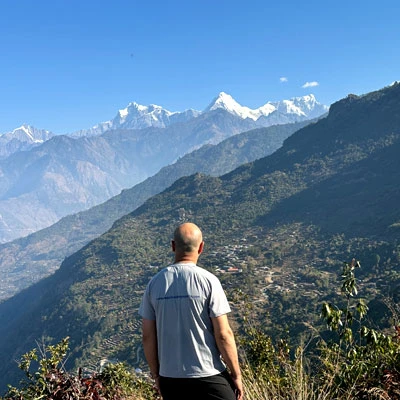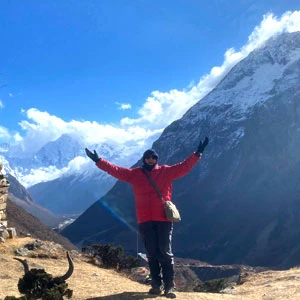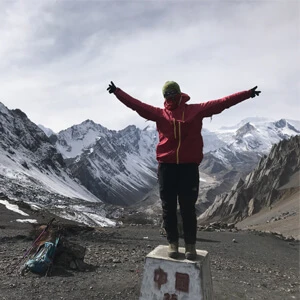Why Trek Nar Phu Valley?
Trekking the Nar Phu Valley takes you to a secluded journey rising to an altitude of over 5,000 meters. This trail leads you through a dramatic high-altitude desert landscape marked by deep gorges, ancient Tibetan-style villages, medieval monasteries, and towering snow-capped peaks.
What sets Nar Phu apart is its status as a restricted area, which means you won’t find crowds or commercialization, but you will need special permits and a licensed guide. This status added a layer of regulation to keep the region pristine.
Cost Breakdown Overview
Below is a chart depiction of the total cost breakdown during the Nar Phu Valley Trek.
Categories | Estimated Cost (in USD) |
Nar Phu Restricted Area Permit | 75 (during Dec to Aug) & 100 (during Sept to Nov) |
Annapurna Conservation Area Permit | Approx. 25 |
Guide (mandatory) | 25 to 35 per day excluding tips |
Porter (optional) | 20 to 25 per day excluding tips |
Transportation | 60 to 100 for round trip |
Food and Accommodation | 25 to 40 per day |
Gear Rental / Purchase | 50 to 200 (as per your need) |
Miscellaneous Expenses | 100 to 200 (for extra expenses) |
Permits And Entry Costs
Before you can set foot in the mystical Nar Phu Valley, you will need to secure the right permits. Because Nar Phu is a restricted region, the Nepali government requires extra paperwork to preserve its fragile environment and culture.
The main permit you will need is the Nar Phu Valley Restricted Area Permit (RAP) and Annapurna Conservation Area Permit (ACAP). The RAP is mandatory for all trekkers, and you can only obtain it through a government-registered trekking agency. If you are a solo traveler, you cannot apply independently.
The cost of RAP depends on the season: USD 100 for 7 days during the prime trekking months of September to November, and USD 75 during the off-season (December to August). If you are planning a longer adventure, you can extend the permit at USD 15 per additional day.
As for the ACAP, it’s a one-time fee of USD 25 per person and applies to all treks in the region, from Annapurna Base Camp to Nar Phu Valley Trek.
Tips
- Since the Restricted Area Permit (RAP) can only be issued via government-registered trekking agencies, make sure you choose a reliable and experienced agency like Nepal Trekking Experts.
- Since the RAP covers only 7 days, any additional time in the restricted area costs USD 15 per day. Carefully map out your route to avoid unexpected extensions.
- You will need a few passport-sized photos and photocopies of your passport when applying for permits. Hence, it’s a good idea to keep extras in your backpack.
- Always carry printed permits and a digital backup (on your phone or cloud). You will be required to show them at various checkpoints.
Guide And Porter Costs
Hiring a guide isn’t optional when trekking the Nar Phu Valley, it’s legally required. As a restricted area, Nar Phu Valley does not permit solo trekkers, and for good reason. Your guide must be government-licensed and must be tied with a registered local agency.
The guide will help you with navigation as well as help manage permits, bridge language gaps in traditional villages, and ensure your safety across high passes and isolated paths. You should expect to pay around USD 25 to 35 per day, depending on their experience, language proficiency, and first aid support.
While porters aren’t mandatory, they are incredibly helpful, especially on a trek as demanding as this. The terrain is rugged, and the altitude often climbs above 5,000 meters, which can leave you exhausted every day.
Hence, hiring a porter helps you carry your load up to 20 kg. Porters typically charge you between USD 20 to 25 per day.
Tips
- Since guides are mandatory for the Nar Phu trek, make sure yours is government-licensed. Licensed guides are trained in high-altitude safety, first aid, and often speak multiple languages.
- Make sure you hire your guide and porter from a registered local agency as they ensure fair pay and insurance coverage. It also helps you avoid last-minute scams or untrained freelancers.
- When budgeting for your guide and porter, ask whether their meals, accommodation, insurance, and transportation are included.
- If you are on a tight budget but still want support, consider hiring a porter-guide, they are experienced enough to guide and carry a light load. They usually charge 30 to 35 per day excluding tips.
- A porter can carry up to 20 kg, but it’s important to pack mindfully and not overload them.
- Tipping is customary and deeply appreciated in Nepal’s trekking culture. A common guideline is USD 5 to 10 per day for guides and USD 3 to 7 per day for porters, depending on service quality and group size.
Transportation Costs
The trek officially kicks off from Jagat, which is accessible by road from Kathmandu. You will have three main options: a local bus, a tourist bus, or a private jeep. The local bus is the cheapest, but brace yourself for a bumpy, crowded ride that can stretch over 8 to 10 hours.
If you are seeking a bit more comfort without spending too much, the tourist bus offers a middle ground. It has better seats, fewer stops, and a more relaxed journey. But if comfort, flexibility, and time matter more than cost, a private jeep is the way to go.
Though it's pricier, it allows you to travel at your own pace and enjoy a smoother ride. For a budget trip, you can also share the jeep with fellow trekkers.
Once your trek wraps up in Chame, you will retrace your way to Besisahar, the main transport hub for the region. From there, you will once again face the choice between a bus or private jeep to get back to Kathmandu. Buses remain the budget option, but they’re often packed and slow.
In total, you should expect to spend anywhere from USD 30 to 100+ on transportation depending on your choices and whether you are sharing.
Tips
- Book your transportation in advance to secure your spot, especially if you are aiming to travel during trekking seasons (March to May and September to November).
- Since private jeeps can be expensive solo, hence, you can share it to reduce the cost.
- The roads from Kathmandu to Jagat and from Chame back to Besisahar can be rugged, therefore, you must be prepared for a bumpy, dusty ride, regardless of the vehicle type.
Daily Expenses (Food And Accommodation)
Throughout the trail, you will find basic tea houses and lodges that offer the essentials: a modest room, a warm meal, and often stunning Himalayan views just outside your window. You will generally spend around USD 25 to 40 per day, which typically covers a bed for the night and three meals: breakfast, lunch, and dinner.
Because Nar Phu lies in a restricted and less-frequented region, everything from rice to tea leaves has to be transported by mule or porter. This naturally drives up food prices, even for simple dishes.
A plate of the staple Dal Bhat (a hearty meal of rice, lentils, and vegetables with free refills) can cost USD 6 to 10, depending on the altitude. Similarly, a cup of tea can cost you anywhere between USD 1 to 3 and snacks like instant noodles or biscuits are also pricier the higher you go.
Tips
- Dal Bhat offers the best value in food as it comes with free refills and keeps you energized.
- Pack dry fruits, granola bars, chocolates, and instant noodles. It saves money and comes in handy when you're hungry between meals.
- Instead of buying bottled water every time, use a refillable water bottle. Also, use a purification tablet or filter to purify water taken directly from the source.
Gear And Equipment Costs
Since the trail of Nar Phu Valley ventures deep into a high-altitude, restricted region, having the right gear is essential. You will need a good-quality down jacket, a warm sleeping bag rated for sub-zero temperatures, trekking poles for balance on uneven terrain, layered clothing for fluctuating weather, waterproof gear for sudden showers, and broken-in hiking boots that can handle rocky trails and snow patches.
If you are not ready to invest in new gear, you can rent almost any gear in Thamel. They charge you around USD 1 to 3 per item per day, including jackets, sleeping bags, poles, and crampons if needed.
But if you plan to trek more often, you should buy your own equipment. You can expect to spend around USD 150 to 300 for a mid-range full set.
Tips
- If you are only trekking once and will not be doing it for a long time, then renting gear and equipment will be better than buying a new one.
- If you already hike or camp at home, bring your own layers or poles to reduce rental or purchase costs.
- Always pack the essential items only and stick to layering to avoid overpacking your bags.
- Never start a trek with brand-new boots. Buy them early, break them in properly, and save yourself from painful blisters.
Miscellaneous Cost
Apart from the major expenses, you will also need to have USD 100 to 200 extra for any miscellaneous cost. While you may not use the entire amount, having extra on hand will be helpful.
First and foremost, you need to have travel insurance with emergency helicopter evacuation. This will prepare you in case of accidents, altitude sickness, or unexpected weather.
Once you are on the trail, you should be prepared to pay a little extra for creature comforts as well. Here, charging your phone, camera, or power bank often costs USD 1 to 3 per use, and Wi-Fi, when available, comes with a similar price tag. These amenities become scarcer the higher you go, and more expensive too.
Similarly, the extra cost can also cover you for buying souvenirs.
Conclusion
Trekking to the Nar Phu Valley isn’t the cheapest adventure in Nepal. The price of this hidden gem rewards you with ancient Tibetan culture, untouched landscapes, and the rare thrill of solitude on the trail.
That said, you don’t need to empty your bank account to get there. With a smart budget, a clear understanding of costs, and a few local hacks, you can experience the raw beauty of Nar Phu without overspending. If you need help planning the trek or managing your expenses, Nepal Trekking Experts can walk you through every detail.
FAQs
Is a guide mandatory for the Nar Phu Valley Trek?
Yes, a licensed guide is required by law as Nar Phu is a restricted area.
Can I trek to Nar Phu Valley solo?
No, solo trekking is not allowed in Nar Phu Valley. You must trek with at least one other person and a guide via a registered agency.
How much do the permits cost for the Nar Phu Valley Trek?
To trek within the Nar Phu Valley, RAP costs USD 100 (during September to November) and it costs USD 75 (during December to August) for the first 7 days. If you stay an additional day, each day will cost you USD 15 extra. Likewise, the ACAP will cost you USD 25 per person and is a one-time payment.
How much does a guide cost per day?
A guide typically costs USD 25 to 35 per day depending on experience and language skills.
Is hiring a porter necessary?
It is optional but recommended; porters cost anywhere between USD 20 to 25 per day and carry up to 20 kg.
What’s the total daily cost for food and accommodation?
You should expect to spend USD 25 to 40 per day including three meals and a basic lodge stay.
Is travel insurance necessary?
Yes, it’s highly recommended, especially one that covers emergency helicopter evacuation.







